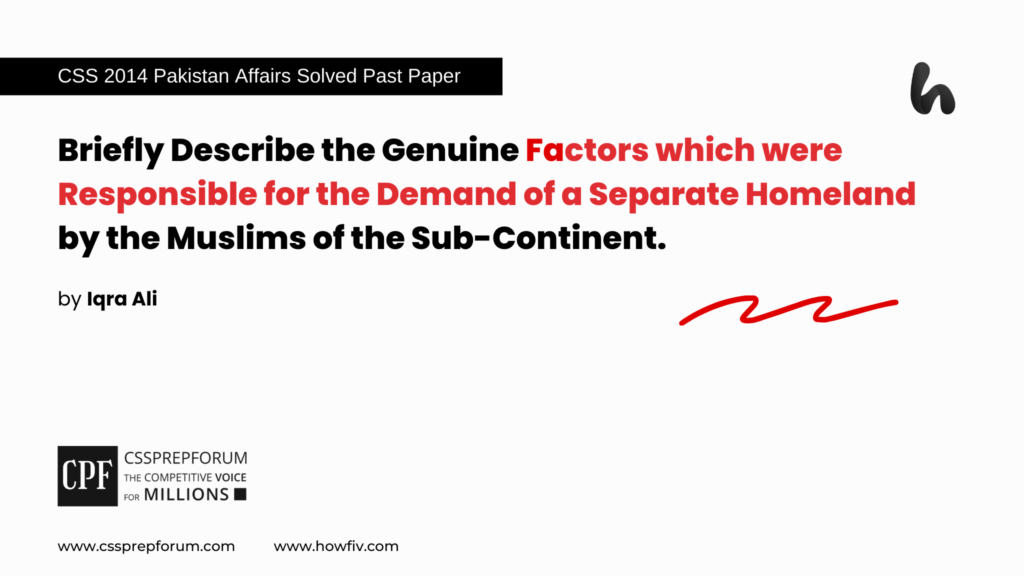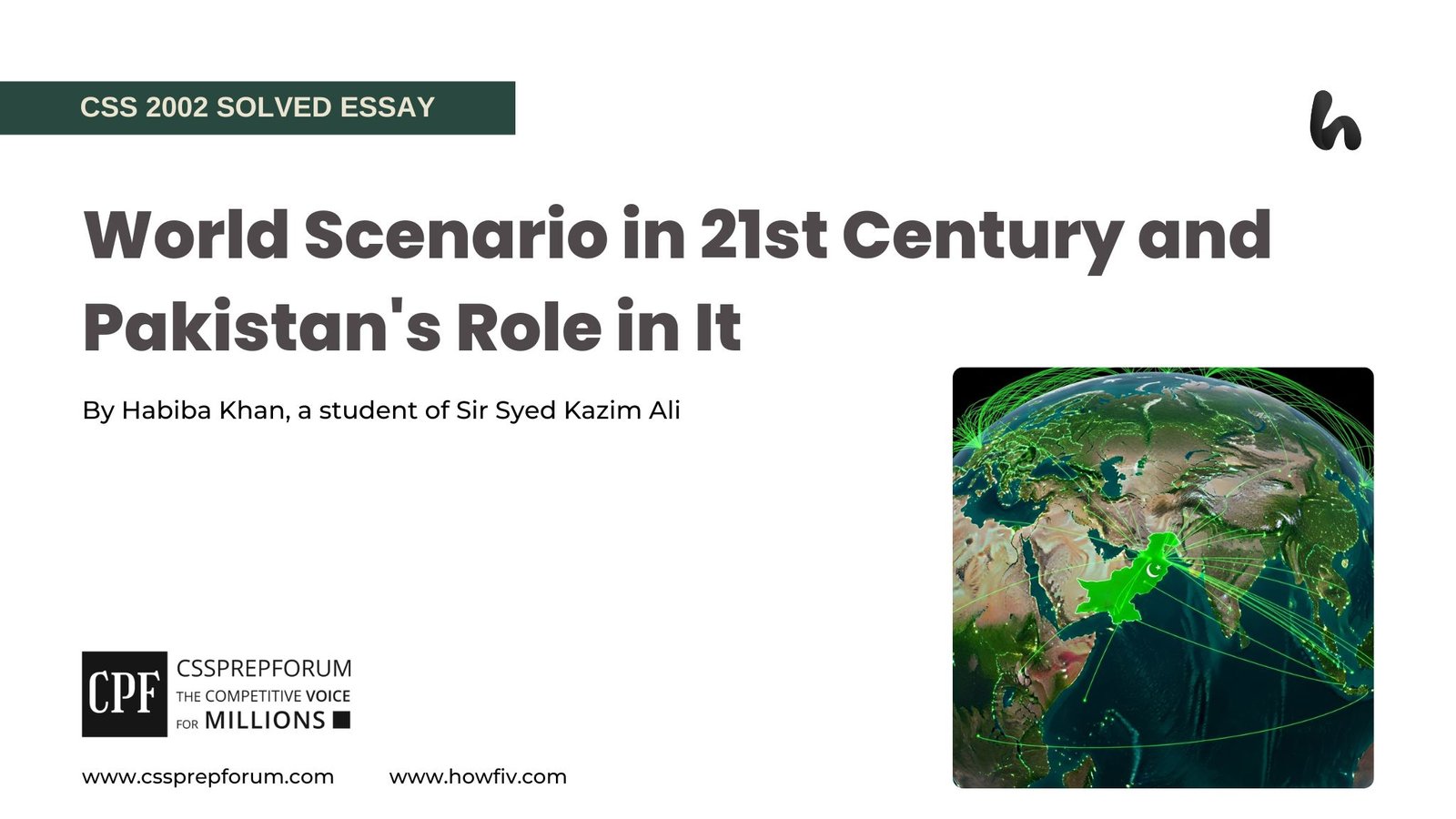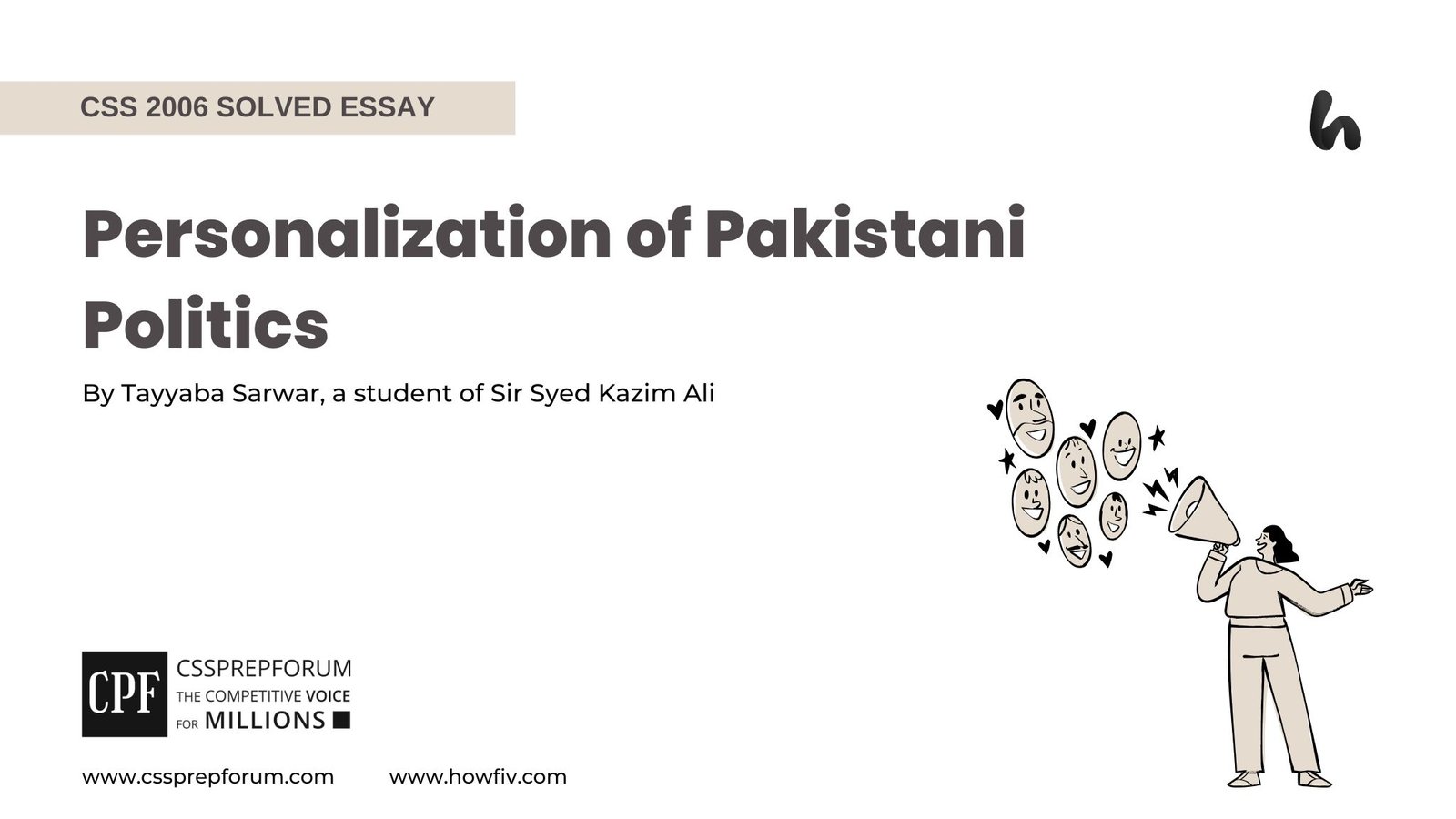CSS 2014 Solved Pakistan Affairs Past Papers | Factors Behind the Demand for a Separate Homeland
The following question of CSS Pakistan Affairs 2014 is solved by Miss Iqra Ali, the best Pakistan Affairs Coach, on the guided pattern of Sir Syed Kazim Ali, which he taught to his students, scoring the highest marks in compulsory subjects for years. This solved past paper question is uploaded to help aspirants understand how to crack a topic or question, how to write relevantly, what coherence is, and how to include and connect ideas, opinions, and suggestions to score the maximum.

Question Breakdown
In this question, the examiner has asked about the elements that constitute the ways for a separate homeland for the Muslims in the Sub-continent. To gain the highest marks, one should provide a concrete understanding of the question by giving a comprehensive introduction and then all the contributing factors for the demand for a separate homeland for Muslims in the Sub-Continent.
Outline
1- Introduction
- ✓ The demand for a separate homeland was a response to the political, economic, and social marginalization faced by Muslims in British India.
- ✓ It stemmed from the realization that Muslims’ distinct identity could not be safeguarded within a Hindu-majority state.
- ✓ The culmination of these factors led to the historic demand for Pakistan, articulated through the Two-Nation Theory.
2- What were the factors behind demand of a separate homeland by the Muslims of the sub-continent?
- ✓ Religious and Cultural Distinctiveness
- Religious Identity
- Islam’s unique social, legal, and moral framework contrasted sharply with Hinduism.
- Cultural Divergence
- Differences in festivals, traditions, dress, and dietary practices reinforced separation.
- Language Conflict
- Urdu, the preferred language of Muslims, faced resistance from the Hindi movement.
- Religious Identity
- ✓ Political Marginalization
- Decline of Muslim Rule
- The fall of the Mughal Empire led to the loss of political power and representation for Muslims.
- Indian National Congress (INC)
- Perceived as a Hindu-majority party that neglected Muslim interests and aspirations.
- Limited Representation
- Reforms like the Montagu-Chelmsford (1919) failed to ensure fair Muslim representation.
- Decline of Muslim Rule
- ✓ Economic Disparities
- Muslim Economic Decline
- Post-1857 policies disrupted traditional Muslim industries, pushing many into poverty.
- Hindu Economic Dominance
- Hindus controlled commerce and trade, marginalizing Muslim artisans and traders.
- Muslim Economic Decline
- ✓ British Colonial Policies
- Divide-and-Rule Tactics
- Policies like separate electorates (1909) aimed to maintain communal divisions.
- Partition of Bengal (1905)
- The annulment in 1911 alienated Muslims, highlighting British unreliability.
- Divide-and-Rule Tactics
- ✓ Rise of Hindu Nationalism
- Anti-Muslim Movements
- Campaigns like the Cow Protection Movement and Shuddhi (reconversion) efforts alienated Muslims.
- Hindu Extremist Organizations
- Groups like the Hindu Mahasabha promoted a Hindu-dominated vision of India.
- Anti-Muslim Movements
- ✓ Evolution of Muslim Political Ideology
- Role of Sir Syed Ahmad Khan
- Advocated for Muslim education and political awareness.
- Two-Nation Theory
- Allama Iqbal’s idea of Muslims as a separate nation with distinct rights and identity.
- Leadership of Jinnah
- Transitioned from a supporter of Hindu-Muslim unity to a staunch advocate for a separate Muslim state.
- Role of Sir Syed Ahmad Khan
- ✓ Global Islamic Influence
- Khilafat Movement
- Strengthened Muslim solidarity and awareness of their collective identity.
- Pan-Islamism
- Inspired Muslims to seek unity and independence globally and locally.
- Khilafat Movement
- ✓ Failure of Hindu-Muslim Unity
- Congress’s Unilateral Approach
- The refusal to address Muslim concerns during key events, like the Nehru Report (1928), widened the divide.
- Communal Tensions
- Increasing hostility in the socio-political landscape underscored the need for separation.
- Congress’s Unilateral Approach
3- Conclusion

Answer to the Question
Introduction
The demand for a separate homeland for Muslims in the Indian subcontinent emerged as a natural consequence of their unique religious, cultural, and political identity. Rooted in centuries of distinct civilization and traditions, the Muslims of India faced increasing marginalization under British colonial rule and the growing dominance of Hindu-majority politics. Therefore, their grievances were not merely material or political but extended to the existential fear of being assimilated into a socio-political order that did not represent their values, beliefs, or aspirations. According to the researches and statistics, Muslims held less than 15% of the jobs in the Indian civil services by 1947, despite their substantial share in the population. Moreover, the weakening of the Mughal Empire and subsequent British policies further exacerbated the disenfranchisement of Muslims, leaving them economically vulnerable and politically excluded. In stark contrast, the Indian National Congress, perceived as a vehicle for Hindu nationalism, systematically ignored Muslim demands, fostering a deep sense of alienation. This exclusion coincided with the rise of a global Islamic awakening and the crystallization of the Two-Nation Theory, which emphasized that Hindus and Muslims were two distinct nations with irreconcilable differences in religion, culture, and social structure. Later, guided by visionary leaders like Sir Syed Ahmad Khan, Allama Iqbal, and Muhammad Ali Jinnah, the demand for a separate state became a clarion call for Muslims to reclaim their identity and secure a future where their political, cultural, and economic rights would be protected.
What were the factors behind the demand for a separate homeland by the Muslims of the sub-continent?
A- Religious and Cultural Distinctiveness
- Religious Identity
Besides, the demand for a separate homeland by the Muslims of the subcontinent was deeply rooted in their distinct religious identity, which shaped every facet of their social, legal, and cultural lives. Islam provides Muslims with a comprehensive way of life, governing not just spiritual matters but also societal norms, economic principles, and political structures. This holistic worldview contrasted significantly with Hinduism, which dominated the cultural and political landscape of British India. Meanwhile, the fundamental differences in beliefs, such as monotheism versus polytheism and distinct codes of ethics and jurisprudence, highlighted the incompatibility of the two communities under a single socio-political framework. Moreover, the rise of Hindu revivalist movements, such as Shuddhi and Sangathan, which aimed to assimilate Muslims into the Hindu fold, further alienated the Muslim community. In the same manner, efforts to impose Hindu-centric practices and symbols in public life, such as the promotion of Bande Mataram and the Hindi language, were seen as direct threats to Muslim identity. These developments fostered a collective realization among Muslims that their religious and cultural identity could only thrive in an environment where they held political autonomy. So that, this growing awareness became a cornerstone of their demand for a separate homeland, ensuring the preservation and flourishing of their distinct way of life.
- Cultural Divergence
In the same context, the cultural divergence between Muslims and Hindus in the subcontinent was a profound factor behind the demand for a separate homeland. Muslims cherished a rich cultural heritage deeply intertwined with Islamic traditions, art, and values, which stood in stark contrast to the predominantly Hindu ethos of Indian society. Their architecture, music, attire, and cuisine bore the influences of Persian, Central Asian, and Arab civilizations, setting them apart from Hindu cultural practices rooted in ancient Indian traditions. So, this divergence extended to social customs, festivals, and modes of living, reinforcing a distinct cultural identity. In all, attempts by Hindu revivalist movements to impose their cultural dominance, such as promoting Hindi over Urdu and marginalizing Islamic practices, exacerbated tensions. Muslims increasingly felt the need for a separate space where their cultural uniqueness could thrive without the fear of assimilation or suppression, making cultural divergence a key impetus for the demand for a homeland.
- Language Conflict
Simultaneously, the language conflict was a pivotal factor driving the demand for a separate homeland, as it symbolized the deeper cultural and ideological rift between Muslims and Hindus. Urdu, cherished by Muslims as a unifying symbol of their cultural and literary identity, became a target of resistance from the Hindi movement, which sought to replace it with Hindi written in the Devanagari script. Similarly, this movement, driven by Hindu nationalist aspirations, dismissed Urdu’s rich heritage and marginalized its significance in public and administrative spheres. The deliberate sidelining of Urdu was perceived by Muslims as an attack on their identity and an attempt to suppress their distinct linguistic and cultural expression, further intensifying their resolve to seek a homeland where their language and heritage would flourish unimpeded.
B- Political Marginalization
- Decline of Muslim Rule
At the same time, the decline of Muslim rule in the subcontinent marked the beginning of profound political marginalization for the Muslim community. Once the architects of a flourishing empire, Muslims found themselves sidelined in the wake of British colonial dominance and the rise of Hindu-majority politics. Elsewhere, the dismantling of the Mughal Empire not only eroded their political power but also left them economically weakened and socially vulnerable. With the British systematically favoring Hindus in administrative and educational reforms, Muslims were deprived of opportunities to participate in governance. By the early 1900s, Muslims held fewer administrative positions. In the 1901 Census, Muslims accounted for about 24.1% of the population, but their representation in civil services was disproportionately low, around 12.5%. Furthermore, this marginalization deepened with the Indian National Congress emerging as the dominant political platform, often ignoring or undermining Muslim interests. The growing realization of their diminishing influence and the lack of a fair political platform drove Muslims to demand a separate homeland where their political and cultural aspirations could be safeguarded.
- Indian National Congress (INC)
Additionally, the Indian National Congress (INC), established in 1885, initially aimed to represent all communities in its struggle for political reform under British rule. However, over time, it became increasingly dominated by Hindu leaders and largely ignored the political, cultural, and economic concerns of Muslims. The INC’s reluctance to accommodate separate Muslim representation and its opposition to key Muslim demands, such as the recognition of Urdu and protection of minority rights, alienated the Muslim community. Eventually, this exclusionary stance fostered a perception among Muslims that the Congress primarily represented Hindu-majority interests, leaving them politically marginalized. So, the growing rift between the two communities highlighted the need for Muslims to seek a separate platform to assert their identity and secure their rights, ultimately fueling the demand for an independent homeland.
- Limited Representation
Further, the limited representation of Muslims in political and administrative structures under British colonial rule was a significant factor in their growing disenfranchisement. Despite being a substantial segment of the population, Muslims were systematically underrepresented in legislative councils, civil services, and other key institutions. Moreover, the introduction of reforms like the Morley-Minto Reforms of 1909, while granting Muslims separate electorates, provided only minimal political representation, failing to address their broader concerns. This token inclusion further underscored their marginal status in a system dominated by Hindu-majority politics and British favoritism. As a result, frustrated by this systemic neglect and the lack of equitable participation, Muslims began to recognize the necessity of a separate homeland where they could exercise self-determination and ensure fair representation in governance.
C- Economic Disparities
- Muslim Economic Decline
Consequently, the economic decline of Muslims in the subcontinent played a critical role in the provision of their demand for a separate homeland. After the fall of the Mughal Empire, Muslims gradually lost their economic dominance, especially with the rise of British colonial rule and the consolidation of capitalist structures that largely benefited the Hindu merchant and landowning classes. Likewise, the Industrial Revolution, which took root in British India, left Muslims, particularly in rural areas, economically marginalized. Additionally, educational and employment opportunities were limited for Muslims, as British policies favored the Hindu population in these areas. Then, this widening economic gap between Hindus and Muslims led to a growing sense of economic insecurity among the Muslim community. As their economic condition worsened, Muslims began to realize that their survival and prosperity could only be ensured in a separate state where they could control their economic destiny and secure a fair share of resources.
- Hindu Economic Dominance
Accordingly, the economic landscape of British India was largely shaped by the rising influence of the Hindu community, particularly in trade, industry, and agriculture. With British policies favoring Hindu elites, Muslims found themselves increasingly excluded from economic opportunities. Similarly, Hindu businessmen, traders, and landowners capitalized on the colonial economy, controlling the bulk of wealth, while Muslims, especially in urban and rural areas, faced significant economic decline. Momentarily, this growing Hindu economic dominance was also reflected in the establishment of businesses, educational institutions, and administrative roles, where Muslims were underrepresented. The resulting economic inequality fostered resentment among Muslims, who perceived this imbalance as an extension of political and social marginalization. The widening economic gap and the dominance of one community in the economic sphere contributed to the belief that Muslims could not thrive under such an unequal system, leading to the demand for a separate state where they could control their own economic future.
D- British Colonial Policies
- Divide-and-Rule Tactics
One of the key factors behind the demand for a separate homeland was the British colonial strategy of divide-and-rule, which deliberately exacerbated existing divisions between Hindus and Muslims. By promoting policies that favored one group over the other, the British created a climate of distrust and competition, ensuring that the two communities were divided politically, socially, and economically. Measures such as separate electorates for Muslims introduced in the Morley-Minto Reforms of 1909, while seemingly beneficial, only deepened communal divisions and made collaboration between the communities more difficult. Certainly, the British also manipulated religious identities and exploited tensions, fostering a sense of insecurity among Muslims, who feared that their political and cultural interests would be overshadowed by the Hindu majority. This colonial strategy of fostering division rather than unity further reinforced the idea that Muslims could only safeguard their interests in a separate, independent nation, free from the manipulative interference of colonial rulers.
- Partition of Bengal 1905
Next, the Partition of Bengal in 1905 served as a catalyst for the growing sense of political and cultural separation between Hindus and Muslims. Initially justified by the British as an administrative necessity, the partition aimed to divide the province into two, with a Muslim-majority eastern region and a Hindu-majority western region. However, the real intent behind the partition was to weaken the nationalist movement by sowing discord between the two communities. While it gained initial support from Muslims, who saw it as a way to promote their political interests, it was strongly opposed by Hindus, particularly in the western part, who perceived it as a deliberate attempt to divide and weaken their political power. Besides, the backlash from the Hindu community, coupled with growing Muslim dissatisfaction after the partition’s revocation in 1911, led to a shift in Muslim political thinking. Thus, the episode highlighted the potential for communal divisions to be politically manipulated, making Muslims realize that their future political security could only be ensured in a separate nation where they could control their own destiny.
E- Rise of Hindu Nationalism
- Anti-Muslim Movements
Next to it, the rise of Hindu nationalism in the late 19th and early 20th centuries further fueled the demand for a separate homeland for Muslims. As movements like the Arya Samaj and the Hindu Mahasabha gained momentum, they began promoting the idea of a Hindu-centric India, which marginalized Muslims and their distinct cultural and religious identity. Anti-Muslim campaigns, such as the Shuddhi (purification) and Sangathan (organization) movements, sought to reconvert Muslims to Hinduism, creating an atmosphere of religious intolerance and hostility. So that, these movements not only intensified communal divisions but also underscored the Muslim community’s vulnerability within a political system dominated by Hindu majoritarianism. The rise of Hindu nationalism highlighted the need for Muslims to safeguard their religious, cultural, and political rights, leading to the call for a separate homeland where they could live free from the threat of assimilation and cultural erasure.
- Hindu Extremist Organizations
Moreover, the emergence of Hindu extremist organizations in the early 20th century played a significant role in intensifying communal tensions and fostering the demand for a separate Muslim homeland. Groups like the Rashtriya Swayamsevak Sangh (RSS) and the Hindu Mahasabha espoused ideologies centered on the supremacy of Hinduism and sought to create a state that reflected exclusively Hindu values. These organizations often engaged in violent rhetoric and actions against Muslims, advocating for their exclusion from the political and social mainstream. Meanwhile, the increasing influence of these groups, coupled with their open hostility toward Muslim identity and rights, alarmed the Muslim community, making it clear that their future within a Hindu-majority India could be perilous. Therefore, rise of such extremist movements reinforced the belief among Muslims that only in a separate nation could they preserve their religious and cultural integrity, free from the threat of radicalization and persecution.
F- Evolution of Muslim Political Ideology
- Role of Sir Syed Ahmad Khan
Eventually, Muslim leaders played a pivotal role in shaping the political consciousness of Muslims in the subcontinent, laying the foundation for the evolution of Muslim political ideology. In the aftermath of the 1857 rebellion, Sir Syed recognized the need for Muslims to adapt to the changing political landscape under British rule. He emphasized the importance of modern education, urging Muslims to engage with Western knowledge while preserving their Islamic identity. His efforts to bridge the gap between Muslims and the British administration led to his advocacy for Muslim cooperation with the British, while simultaneously promoting the protection of Muslim rights. Sir Syed’s ideas of political engagement, along with his belief in the necessity of separate Muslim representation in government, set the stage for the formation of the All-India Muslim League and the eventual demand for a separate homeland. His work inspired a generation of Muslim leaders to recognize the importance of political autonomy, establishing a vision for a Muslim-majority state where their rights and culture could be preserved.
- Two Nation Theory
Similarly, the Two-Nation Theory, a foundational concept in the demand for a separate Muslim homeland, posited that Hindus and Muslims were distinct nations, with their own customs, religion, culture, and social practices. This ideology was prominently championed by leaders like Sir Syed Ahmad Khan and later by Muhammad Ali Jinnah. The theory argued that Muslims and Hindus could not coexist within a single nation due to their deep-rooted differences in beliefs and ways of life. Jinnah, in particular, emphasized that the political and cultural interests of Muslims could not be safeguarded in a Hindu-majority India. Hence, the Theory not only provided the intellectual basis for the creation of Pakistan but also crystallized the political and social divide between the communities, making the case for a separate Muslim state where Muslims could exercise autonomy and preserve their distinct identity.
- Leadership of Jinnah
Henceforth, Muhammad Ali Jinnah’s leadership was instrumental in turning the demand for a separate Muslim homeland into a reality. Known as the “Quaid-e-Azam,” Jinnah was a masterful strategist who articulated the aspirations of Muslims through the lens of the Two-Nation Theory, advocating for the distinct identity and political rights of Muslims in the subcontinent. Initially a member of the Indian National Congress, Jinnah’s vision evolved as he became disillusioned with the Congress’s Hindu-centric policies. His leadership in the All-India Muslim League transformed it from a passive political entity into a formidable force for Muslim rights. In the same manner, Jinnah’s unwavering commitment to securing political autonomy for Muslims, coupled with his pragmatic negotiations and speeches, galvanized the Muslim masses and earned him their trust. His decisive role in the Lahore Resolution of 1940, which called for the creation of Pakistan, and his ability to unite diverse Muslim factions, cemented his legacy as the key architect of Pakistan’s creation. Through his leadership, Jinnah not only articulated the political aspirations of Muslims but also provided a clear vision for the future of a separate nation where Muslims could thrive.
G- Global Islamic Influence
- Khilafat Movement
Later, The Khilafat Movement, launched in the early 20th century, played a crucial role in uniting Muslims across the subcontinent under a common cause: the preservation of the Ottoman Caliphate, which was viewed as the spiritual and political symbol of Islamic unity. Following the defeat of the Ottoman Empire in World War I and the subsequent disintegration of the Caliphate, Indian Muslims, led by figures like Maulana Mohammad Ali and Shaukat Ali, spearheaded the movement to protect the institution of the Caliph. The movement not only galvanized Muslim sentiment globally but also fostered a sense of solidarity with the wider Muslim world, highlighting the growing awareness of global Islamic political dynamics. Although, the Khilafat Movement ultimately failed to restore the Caliphate, but it strengthened the political consciousness of Indian Muslims and increased their sense of collective identity. The movement also led to closer cooperation between the INC and the AIML, marking a significant chapter in the evolution of Muslim political thought and the demand for greater autonomy within the British colonial framework.
- Pan Islamism
Similarly, Pan-Islamism, a political and ideological movement that sought to unite Muslims worldwide, significantly influenced the demand for a separate homeland for Muslims in the subcontinent. Rooted in the belief that all Muslims share a common religious and cultural identity, Pan-Islamism called for solidarity among Muslims to protect their rights and interests against Western imperialism. In the context of British India, Pan-Islamic sentiments were amplified by the decline of the Ottoman Empire and the disintegration of the Caliphate, as well as the shared experiences of colonial oppression faced by Muslims across the globe. Likewise, leaders like Sir Syed Ahmad Khan and Muhammad Ali Jinnah were influenced by the Pan-Islamic ideal, as it fostered a sense of unity and political awareness among Muslims. This global solidarity helped Muslims in India recognize the importance of safeguarding their political, cultural, and religious autonomy, eventually contributing to the call for an independent Muslim-majority state, where they could maintain their identity free from the dominance of Hindu-majority politics and colonial rule.
H- Failure of Hindu-Muslim Unity
- Congress’s Unilateral Approach
Nevertheless, the failure of Hindu-Muslim unity can be largely attributed to the unilateral approach adopted by the INC, particularly in its dealings with the Muslim community. As the Congress became increasingly dominated by Hindu leaders, it began to prioritize Hindu interests, often sidelining or disregarding the concerns and aspirations of Muslims. The Congress’s refusal to grant Muslims separate political representation, despite their distinct identity and demands, deepened the divide between the two communities. Furthermore, its failure to recognize the cultural and religious differences of Muslims, and its insistence on a united India under a Hindu-majority framework, alienated many Muslim leaders. This lack of inclusivity and respect for Muslim political rights led to growing disillusionment within the Muslim community, which eventually sought a separate political identity under the leadership of the All-India Muslim League. So, the Congress’s unilateral approach thus played a crucial role in the breakdown of Hindu-Muslim unity and the eventual demand for the creation of Pakistan.
- Communal Tensions
For sure, communal tensions between Hindus and Muslims in British India were a significant factor that contributed to the demand for a separate homeland for Muslims. These tensions were often exacerbated by deep-rooted religious, cultural, and political differences, compounded by British colonial policies that exacerbated divisions for their own strategic benefit. Over time, communal violence, fueled by both political and social grievances, became more frequent, leading to mistrust and hostility between the two communities. The growing fear among Muslims of being politically and culturally dominated by the Hindu majority, particularly as the Congress movement gained strength, further heightened tensions. Consequently, riots and violent clashes, coupled with discriminatory practices in administration and governance, reinforced the belief that Muslims could not coexist peacefully in a unified India. This environment of growing animosity and the failure to address communal issues led to the belief among many Muslims that only in a separate state, where they could preserve their distinct identity and safeguard their rights, could they ensure peace and security.
Conclusion
In a nutshell, the demand for a separate homeland for Muslims in the subcontinent was the result of a complex interplay of historical, political, social, and economic factors. From the decline of Muslim political power after the Mughal Empire to the growing sense of religious and cultural divergence, Muslims increasingly recognized the need to protect their identity and political rights. Equally, the failure of Hindu-Muslim unity, compounded by British colonial strategies, anti-Muslim movements, and the rise of Hindu nationalism, further deepened the divide. The leadership of figures like Sir Syed Ahmad Khan and Muhammad Ali Jinnah, along with the influence of Pan-Islamism and the Khilafat Movement, solidified the vision for a separate Muslim state. Lastly, the evolution of Muslim political ideology, driven by the desire for self-determination, political autonomy, and protection of cultural heritage, culminated in the creation of Pakistan. This demand was not merely a reaction to external forces but a conscious effort to carve out a space where Muslims could thrive, free from domination and marginalization.
CSS 2014 Solved Pakistan Affairs
CSS Solved Past Papers’ Essays
Looking for the last ten years of CSS and PMS Solved Essays and want to know how Sir Kazim’s students write and score the highest marks in the essays’ papers? Then, click on the CSS Solved Essays to start reading them.
CSS Solved Essays
CSS Solved General Science & Ability Past Papers
Want to read the last ten years’ General Science & Ability Solved Past Papers to learn how to attempt them and to score high? Let’s click on the link below to read them all freely. All past papers have been solved by Pakistan’s top CSS GSA coach having the highest score of their students.
General Science & Ability Solved Past Papers












